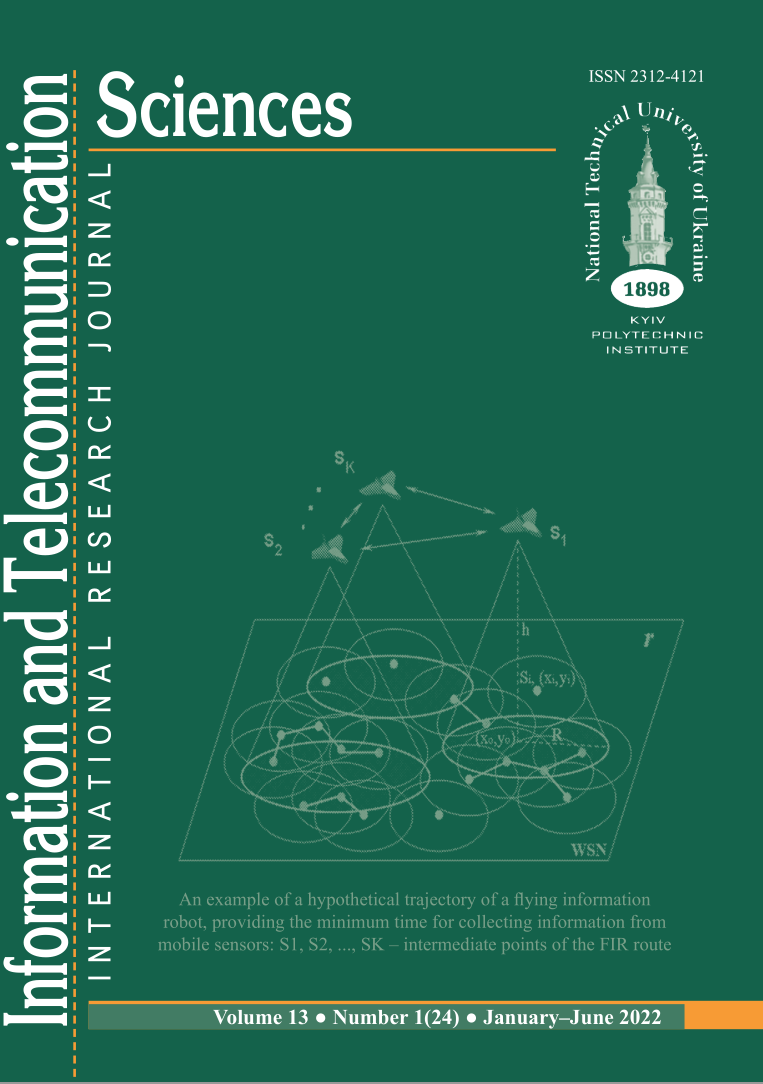METHOD OF OPERATIONAL CALCULATION OF COORDINATES OF INTERMEDIATE ROUTE POINTS OF FLYING INFORMATION ROBOT
DOI:
https://doi.org/10.20535/2411-2976.12022.27-34Keywords:
movement trajectory, flying information robot, mobile wireless sensor network, wireless episodic network, unmanned aerial vehicle, connectivity, topology controlAbstract
Background. The article describes an operational calculation method of the intermediate points' coordinates of the flying information robot (FIR) route, which collects information from mobile sensors of a mobile wireless sensor network.
Objective. The purpose of the paper is to develop a method that allows building the movement trajectory of the LIR, minimizing the time for collecting information from mobile sensors.
Methods. The quickly calculating method of the route' coordinates of intermediate points involves setting a quasi-mobile mode of sensors movement and the consistent use of algorithms for solving the navigation problem, the clustering problem, and the problem of finding the flying trajectory around information collection points from mobile sensors clusters that formed at the time of the start of collecting information.
Results. A method has been developed that uses the procedures of quantitative calculation of the indicators of the structural-information connectivity of wireless sensor networks with mobile sensors. These indicators take into account the presence of not only a structural connection, but also a guaranteed information exchange between a given sender-destination pair.
Conclusions. The developed method makes it possible to improve the indicators of the structural-information connectivity of wireless sensor networks with mobile sensors: k-connectivity and network bandwidth.
References
Lysenko, O., Romaniuk, A., Zhuk, O., Romaniuk, V., Increasing the efficiency of data gathering in clustered wireless sensor networks using UAV, in: Information and Telecommunication Sciences, volume 1, 2020, pp.102 – 107.
Imad Jawhar, Nader Mohamed, Jameela Al-Jarood, UAV-based data communication in wireless sensor networks: Models and Strategies, International Conference on Unmanned Aircraft Systems (ICUAS), 2015.
Huseyin Okcu, Mujdat Soyturk, Distributed Clustering Approach for UAV Integrated Wireless Sensor Networks, in:International Journal of Ad Hoc and Ubiquitous Computing,
volume15, 2014, pp.106 – 120.
Asim Zeb, A. K. M. Muzahidul Islam, Mahdi Zareei, Ishtiak Mamoon, Nafees Mansoor, Sabariah Baharun, Yoshiaki Katayama, Shozo Komaki, Clustering Analysis in Wireless Sensor Networks: The Ambit of Performance Metrics and Schemes Taxonomy, in: International Journal of Distributed Sensor Networks, 2016.
Tony Ducrocq, Michaël Hauspie, Nathalie Mitton, Balancing Energy Consumption in Clustered Wireless Sensor Networks ISRN Sensor Networks, 2013, http://dx.doi.org/10.1155/2013/314732.
Bakhtin, A., Development of methods of connectivity and quality of service in mobile ad hoc networks with retransmission: Abstract. dis. Candidate for the degree. tech. Science: special. 05.12.13Systems, networks and telecommunications device, 2009.
Ilchenko, M., Telecommunication systems based on high-rise aeroplatform, NaukovaDumka, 2008.
Lysenko, O., Valuiskyi, S., The method of optimal control of network topology by the criterion of improving connectivity of wireless ad-hocnetworks, Management systems, navigation and communication, volume2(14), 2010, pp. 218 – 224.
Minochkin, A., Romaniuk, V., Objectives of the unmanned aerial vehicles network topology of military communication networks mobile component, Collected Works of VITI"KPI", volume2,2005, pp. 83–90.
Chandrashekar, J., Dekhordi, K., Baras M., Providing full connectivity in large ad-hoc networks by dynamic placement of aerial platforms. In Proceedings of IEEE MILCOM'04, volume2,2004, pp. 1429 – 1436.
Basu, P., Redi, J., Shurbanov, V., Coordinated Flocking of UAVs for Improved Connectivity of Mobile Ground Nodes, in: Proceedings of IEEE MILCOM'04, volume.3,2004, pp. 1628 - 1634.
Han, Z., Swindlehurst, A., Liu, K., Smart deployment / movement of unmanned air vehicle to improve connectivity in MANET, in:Proceedings IEEE Wireless Commun. network conference, volume1,2006, pp. 252 - 257.
Popovsky V., Mathematical foundations of the theory of telecommunication systems, LLC "Smith", 2006.
Ilchenko M., Bunin, S., Voyter, A., Mobile radio networks with packet switching, NaukovaDumka, 2003.
Romaniuk А., The UAV monitoring data collection management tasks in wireless sensor networks. Collection of scientific papers MІТІ, volume2, 2018, pp. 103 – 112.
Romaniuk A., Method of the date collecting in wireless sensor networks with unmanned aerial vehicles, Collection of scientific papers MІТІ, 2018, volume, pp. 90 – 99.
Romaniuk V., Zhuk O., Tkachenko D., Power management in wireless sensor networks. Bulletin of NTU “KhPI”, Series: Mechanical-technological systems and complexes, Kharkov: NTU “KhPI”, volume20, 2017, pp. 53 – 59.
Zagorujko N., Prikladnye metody analiza dannyh i znanij, Novosibirsk:IM SO RAN, 1999.
Safwan Alfattani, Wael Jaafar, Halim Yanikomeroglu, AbbasYongacoglu, Multi-UAV Data Collection Framework for Wireless Sensor Networks, 2019, Retrieved from https://arxiv.org/ pdf/1910.10792.pdf.
Minochkin, A., Romaniuk, V., Topology management of mobile radio networks, Zv'yazok, volume2,2003, pp. 28-33.
Minochkin, A., Romaniuk, V., Routing protocols in mobile radio networks, Zv'yazok,
volume1,2001, pp. 31 - 36.
Minochkin, A., Romaniuk, V., Analytical modelling of automated radio networks, Collected Works of KVIUZ, volume 1,2001, pp. 88 –94.
Sergiyenko O., Flores-Fuentes, W., Mercorelli, P., Machine vision and navigation, Springer Nature Switzerland, 2020.
Asim Zeb, A. K. M., Muzahidul, Islam, Mahdi, Zareei, and others, Clustering analysis in wireless sensor networks: The ambit of performance metrics and schemes taxonomy, International Journal of Distributed Sensor Networks, 2016.
Huseyin, Okcu, Mujdat, Soyturk, Distributed clustering approach for UAV integrated wireless sensor networks. International Journal of Ad Hoc and Ubiquitous Computing, 2014.


